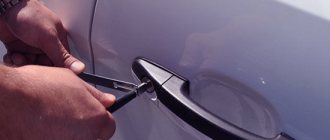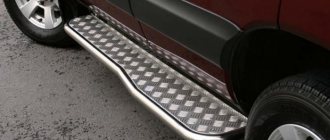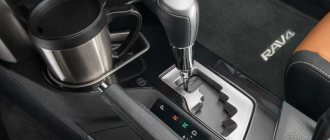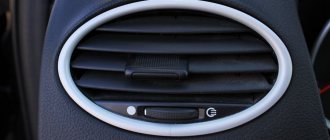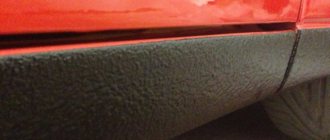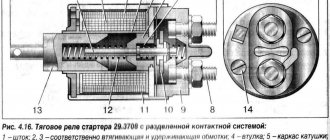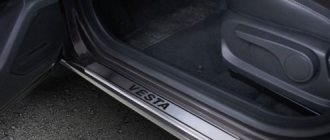If you decide to start painting your vehicle, it is likely that you will be faced with through holes in the body that have arisen as a result of exposure to rust. It is worth noting that body repairs are quite expensive, so not every car enthusiast wants to turn to professionals.
As a result, many are interested in how to repair holes in a car body without welding with their own hands. This is exactly what we will talk about now.
How to repair through holes on a car body using putty without welding
Before repairing a hole in the car body, you should prepare:
- fiberglass and automotive putty;
- aluminum mesh;
- putty knife;
- sandpaper (if possible, it’s also worth looking for a sanding machine);
- primer, paint, varnish.
Fixing holes in a car body itself is distinguished by its simplicity. First of all, you should remove the rust using an angle grinder or any other suitable equipment. Next, we cut out the patch from aluminum, and then attach it to the body using masking tape. We apply a thin layer of fiberglass putty (here it is important not to touch the tape, because then you will have to remove it). When the putty sticks, peel off the tape and putty the remaining areas.
It is important that the layer is as thin as possible, without tubercles or other irregularities.
When everything is dry, sand everything using coarse sandpaper or a sander.
Having achieved a flat and smooth surface, apply a second ball of putty - automotive putty. We wait until it dries and level it again. Then the surface is primed (do not forget to cover the areas that do not require painting with film). When the primer is finished, you can paint the body.
It is worth noting that the patch will be more stable if you apply a couple of layers of putty on the back side. In addition, it is also possible to seal holes in the car body without welding using putty and without using a patch. In this case, it is necessary to apply a lining on the back side so that the composition is well fixed. On the other hand, this solution is only suitable for very small through holes.
Let's watch a detailed video on how to seal holes without welding:
Using a soldering iron
There is another way to repair a hole in a car body without welding. A soldering iron is required here. First of all, we clean the area from rust. We make the patch from a sheet of metal (you don’t need to worry too much about this; an ordinary can of auto chemicals will do).
It is important that the patch is slightly larger than the holes and also completely covers them.
Additionally, you can coat the metal surface with anti-corrosion compounds - this will increase the quality of our repairs. Then we service the edges of the patch, after which, using a fairly powerful soldering iron, we solder it with a continuous seam.
Next, you should check whether it turns out that the patch protrudes somewhat above the body. If there is a protrusion, we eliminate this deformation with several gentle blows of the hammer. We remove various dents with putty (it is important that its layer reaches no more than 2-3 mm, otherwise the material will crack). Before filling, clean the surface with a metal brush.
In order for the putty to adhere well, it is important that abrasive marks (small scratches) appear on the patch.
The next step is primer. Here it is necessary to complete everything as quickly as possible to avoid the possibility of rust occurring in the future. It is best to first apply a thin layer of phosphate primer, and when it dries, another two or three layers of acrylic two-component composition (the interval between applications should be about 5-10 minutes). Everything dries in about 3-4 hours; if there is infrared heating, you can reduce the procedure to 20 minutes.
It is worth noting that this solution is more durable than in the case of aluminum mesh, and it can be used to eliminate holes of almost any size.
What defects may there be?
The procedure and specifics of work when restoring car thresholds depends not only on their type, but also on the damage received.
Damage that can be repaired without welding:
- shallow dents without sharp edges;
- chips of paint coatings due to small pockets of corrosion;
- pinholes caused by corrosion.
Rotten metal thresholds can only be repaired by welding. It is advisable to repair removable elements only in case of minor damage, which can be easily repaired on your own. If the defects are significant, it is better to replace the removable spare part with a new one, since the price of analogues and the cost of repair work are almost equal.
Body repair with putty
This method is used when you urgently need to repair a small hole without welding or there are no other options for car repair. However, it should be understood that this is a temporary measure, since the putty will quickly crumble. To repair the damage, use a special putty with small, medium, and large glass fibers. When preparing it, you need to ensure that there are no air bubbles. To create an even layer, a lining is installed on the back of the hole.
A primer is applied to the prepared area of damage. After it dries, putty with large fibers is applied. Depending on the size of the hole, several layers are applied and each layer is completely dry. The total thickness should not exceed 2 mm, otherwise the patch will begin to crack. The last layer is applied with fine fiber putty. The repaired surface of the car is treated with fine-grained sandpaper.
Preparing a car for anticorrosion
Protecting a car from rust involves several stages. First of all, the car must be prepared for the process. To do this, you need to clean it of existing rust.
Most often it accumulates in the bottom area, so special attention is paid to cleaning it. To do this, you should:
- Wash the surface of the machine thoroughly. It is advisable to go to a car wash, where the car will be thoroughly cleaned of any dirt.
- To remove rust, it is better to use special metal brushes. A drill will help you quickly clean the bottom.
- You should first remove the fender liners from the car, since very often rust forms under them.
After this, you can treat the underbody of the car with an anti-corrosion compound.
Fiberglass and mesh
To repair more extensive damage, an aluminum patch mesh is used. A piece slightly larger than the hole is cut out of it and attached with masking tape. Next, sealing holes in the car body without welding is carried out in the following sequence:
- a thin layer of fiberglass putty is applied without touching the tape;
- after drying, the tape is removed;
- subsequent layers of putty are applied after the previous one has dried;
- the surface of the car is treated with sandpaper or a grinding machine until smooth;
- To strengthen the mesh, several layers of putty are applied to the back of the body.
Long-term auto patches are made from fiberglass and epoxy resin. Several overlays are cut from it, the first of which should cover the hole with a margin of 2 cm. The size of each subsequent piece is made larger than the previous one. The last overlay should cover all the metal stripped during the preparation process.
The cut pieces are impregnated with resin and placed on the hole in a sequence of increasing sizes. If you need to seal large holes on the back of the body, use linings to prevent the fabric from sagging. After laying all layers of fiberglass, wait for the resin to completely harden. The time required for this is indicated in the instructions.
Car body soldering
This method is used to seal small and large holes without welding. To work, you will need flux, which will protect the metal from rapid oxidation. Soldering acid, sold in radio stores, can successfully cope with this task. To achieve the required temperature, you will need a soldering iron with a power of 1 kW or more, or a version heated with a blowtorch, but it is better to use a gas torch. The solder is chosen to be refractory, since it can be used to repair a hole in the car body more reliably.
Small holes are simply filled with solder, starting from the edges and gradually fusing to the center. A large hole in the body is covered with a patch cut from tin from a tin can. It provides:
- strong connection, almost like welding;
- significantly longer service life than putty, but less than welding;
- possibility of sealing large holes;
- ease of implementation, repairs are accessible even to beginners.
The work is performed in the following sequence:
- A patch is cut to fit the size of the hole. The larger the area of contact with the body, the more reliable the connection.
- The soldered edges of the patch and the damaged areas are cleaned with sandpaper until shiny.
- Using flux and solder, the cleaned surfaces are tinned.
- After applying the patch to the repaired area of the car, it is heated to the melting temperature of the solder. In this case, you need to ensure the continuity of the seam so that there are no missing sections.
- After cooling, the remaining flux is removed, and the soldering area is washed with hot water and soda.
How to repair thresholds
The choice of repair method depends on a large number of factors - the skills of the car owner, the availability of tools, the nature of the damage and the type of thresholds. Most defects, regardless of whether the element is removable or non-removable, can be eliminated by almost any car owner on their own.
Removable
This is the simplest repair option, since working with a removable element is easier than with a non-removable analogue. Having unscrewed the part, you can start straightening it, puttying it and all other types of work that may be needed. There is no need to dismantle doors and seats.
The easiest way is to replace the old threshold with a new one - no special tools are needed for this. A wrench is enough to loosen and tighten the bolts. If desired, car thresholds can be made using one of the existing methods.
If the removable metal part has small irregularities, they can be removed using a hood. Minor corrosion damage is repaired with putty.
There are many strong adhesives, resins, and other products on the market today that are used for auto body repair. There are about a dozen options for repairing metal thresholds without welding; let’s look at the most popular ones.
Fiberglass
Repairs using fiberglass are simple, cheap and quite reliable. The material can be replaced with fiberglass or fiberglass. The method is used in the presence of pronounced foci of corrosion, and if there are no traces of impacts or dents. Resin or epoxy glue is used together with the base material.
Pros of fiberglass:
- weighs little;
- convenient to use;
- does not interact with water, acids and other reagents found on the roads;
- long service life;
- low cost.
For repair work, you will need to stock up on brushes, sandpaper, hardener and spatulas of different sizes.
Repair procedure:
- Remove the paint layer with a grinder.
- Sand the defective area with sandpaper.
- Cut out a patch from glass material. Its size should be larger than the source damaged by corrosion.
- Degrease and prime the surface.
- Glue the fiberglass onto the previously applied layer of putty or epoxy glue.
- Putty and prime the surface.
- Treat the area to be repaired with an anti-gravel compound.
- Apply a coat of paint.
When the threshold is completely dry, install it in place and tighten the bolts.
Epoxy adhesive
The most popular glue among car enthusiasts is ED-20. Usually it comes with a PEPA hardener. The compositions are mixed in a ratio of 1:10. When working with glue, it is important to observe safety precautions by wearing appropriate equipment for your eyes and hands.
The repair procedure is almost the same as when using glass materials. If the defect is small, then reinforced mesh may not be used. The glue is simply applied to the damaged area in several layers, putty, primed and painted.
Construction foam
Japanese automakers often use construction foam to fill the boxes of permanent thresholds during factory assembly. This material prevents corrosion inside the element and maintains the parameters of the seal.
Anti-corrosion resins and mastics and polyester components are used as sealants. When repairing rusty thresholds, it is forbidden to blow ordinary construction foam into empty cavities, as this leads to accelerated rotting of the metal.
How to use construction foam to repair thresholds:
- Clean the defective area from rust.
- Apply a thin layer of foam.
- Reinforce the affected area with fiberglass or reinforcing mesh.
- Prime the surface.
The repair of the threshold is completed by applying a special anti-corrosion coating and painting.
Fixed
To repair fixed thresholds, you will need a whole set of tools. The exact list depends on the nature and extent of the damage.
On a note! Spotter is a device for resistance spot welding. Used for straightening parts using the pulling method. A fastening element is welded to the defective plane, using which the dents are pulled out.
When repairing permanent metal thresholds, you may need:
- Bulgarian;
- welding;
- grinding attachments;
- drill and drill bits;
- plumbing tools (spanners, hammer, screwdrivers);
- solvent;
- rust converter;
- fine and coarse sandpaper;
- polishing paste;
- primer;
- putty;
- dye.
You may need tools for straightening and drawing metal.
Procedure and options for repairing non-removable thresholds:
- For minor damage, straighten the unevenness using a hood. The surface can be smoothed using a spotter or an inertial puller.
- If there are significant defects, remove the doors and take out the seats to avoid damage during repairs. Then straighten the damaged areas. To do this, cut a square “window” in the side of the threshold through which you can pull the threshold out using hydraulic tools. After finishing the work, weld the hole.
- Another option is to separate the threshold along the weld seam. In this case, you can straighten the metal using an anvil.
When working with welding, you must follow standard safety precautions - you must wear a protective mask on your face and heat-resistant gloves on your hands.
Plastic
If you decide not to replace the plastic element with a new one, you will have to close the holes in the thresholds. This is done in approximately the same way as on metal analogues.
How to correct defects on plastic thresholds:
- Remove the element to work on it on the workbench.
- Clean the plastic surface from the outside.
- Cut out patches from fiberglass - their size should be slightly larger than the damaged areas.
- Along the edge of the hole, lubricate the plastic with glue and apply patches - one after another, covering each one.
- Press the patches down with a small board, wrapping it with film. From the outside with a special clamp (clamp).
- Turn the threshold over so the wrong side is facing up. Place a couple more patches of glass material and glue on the inner surface.
- After 24, remove the clamps and film.
- Sand the outer surface, degrease and paint.
On a note! To improve adhesion with glue, drill several holes around the perimeter of the hole with a thin drill. You will get reliable connections, like rivets.
Rivets
This method not only repairs large holes in the car body, but also replaces parts (fenders, aprons) without welding. In terms of reliability, it is not inferior to welding. It is recommended to install rivets in an inconspicuous place. Since there is no splash of molten metal during operation, like welding, it is often used to repair car floors.
The riveter required for the job can be bought in a store (costs approximately 500 rubles). The technology is simple:
- The patch is cut so that it overlaps 2 cm around the edges of the hole.
- By attaching it to the body, it is given the desired shape.
- The locations of the holes for the rivets are marked.
- After drilling the patch with a drill according to the diameter of the rivets (4 - 6 mm), it is advisable to countersink the edges of the holes so that it fits more tightly to the surface of the car body.
- Having applied the patch again, the center of the first hole is marked and drilled.
- After riveting it and leveling it, the patches are tapped and the remaining holes are drilled in place.
- To ensure a tight fit of the patch to the car body, rivets are fastened from the center to the edges.
- To prevent moisture from getting inside, the joint around the perimeter and rivets is coated with sealant.
Final stage
Regardless of how the car body was repaired, they all end with putty. However, it absorbs moisture, which leads to rapid destruction. Therefore, it must be coated on top with an anti-corrosion or epoxy primer. Body repairs are completed without welding by painting. To do this, use a spray gun or aerosol cans, after covering the adjacent surface of the car with plastic film. You should not use a brush, as drips are possible.
The proposed methods will help to repair a car without welding in case of single damage. However, if a large area is affected by corrosion, it will be easier and more reliable to contact a car repair shop to replace the rusted area by welding. Most often this happens to the floor, so it is recommended to regularly check it from underneath the car using an inspection hole or lift.
A source of through corrosion, or simply a hole, in the bottom of the car is the price to pay for comfort in the cabin. Its primary source is not anti-icing reagents acting outside, but moisture accumulating under the “pie” of heat, sound and waterproofing. Therefore, when eliminating it, work is carried out mainly from the inside.
If you follow all safety rules when welding, you must completely dismantle the interior, including the trim. This is always very time consuming. Therefore, the question of how to seal the bottom of a car without welding is very relevant. Moreover, most alternative methods do not give worse, but rather better results.
Anticorrosive recipe
The presented products narrow the field of activity for experienced car enthusiasts. The best way to correct the imbalance is to make anticorrosion compound yourself. The complex action of the constituent parts, the consistency of the substance and the volume will definitely satisfy the car owner.
The value of the recipe lies in the availability and cost-effectiveness of most ingredients. The composition is based on bitumen or wax compounds. They envelop the metal of the body and hold the entire mass on the surface. The main option is cannon fat. This is a long-established remedy, trouble-free, low-cost, and commercially available.
The availability of auxiliary components depends on the needs of the master. May include:
- Plasticine. Strengthens the structure, adds plasticity and comfort during processing.
- Waterproofers. Protects against water ingress and rust during operation.
- Anti-corrosion inhibitors. Chemical retardants of the destructive process of rotting of metal parts.
To increase efficiency, metal particles are introduced into the composition for strength (zinc, bronze), plastic or rubber compounds, glue or sealant for additional protection of problem areas.
Will regular paint help?
The composition and properties of conventional paints and varnishes do not allow their use as an alternative to anti-gravel. The absence of anti-corrosion inhibitors eliminates the creation of a protective film and allows the action of chemically aggressive reagents and water to spread. The paint fades quickly, does not prevent the spread of rust, and does not eliminate existing problem areas. Water-repellent properties are at a low level.
Cold methods of sealing holes in metal
There are two ways to repair holes in the underbody of a car without using hot work.
- Using composite materials - various types of polymer resins in combination with a reinforcing filler and a curing reaction accelerator. With high-quality surface treatment, in addition to restoring mechanical strength, they play the role of inhibitors - retarders of chemical and electrochemical corrosion reactions;
- Installing sheet material patches onto rivets.
General technological rules
Holes in the bottom are usually discovered from the outside, when inspecting the car on a pit or lift. Signs of through corrosion are local swellings, which, when you try to pick them out, crumble into dust.
If you find such troubles, you need to open and remove the pie of heat, noise and waterproofing on the floor in the cabin in the entire area where the sheet of iron forming the floor is welded to the power elements of the body - thresholds, tunnel and others. Then you will see the whole picture of the damage and will be able to take preventive measures in those places where corrosion has not yet become through.
Soldering a metal patch
Soldering a metal element to a damaged area is a way to seal holes in the bottom or any other part of a car when you can close a small hole. To repair a machine using this technology, you must have the following tools:
Materials in the car So, first, the area that needs to be repaired is cleaned, paint, rust, and dirt are removed. Next, it is treated with flux and degreased. Then measurements are taken and a metal piece of the desired shape is cut out. Such an element will completely seal the hole, and the edges will overlap. When the part for the patch is ready, it is attached with a soldering iron. Then the edges of the patch are treated with flux. Finally, it is worth treating the area with putty and priming it. When the surface is dry, paint and a protective layer are applied.
This method of filling holes in the bottom of a car is the most popular. Experts note the durability of the soldered patches, since the connection is quite reliable. In addition, this method can be used to seal a hole of any size. In general, soldering a patch is quite simple, and even a beginner who does not have much experience in car repairs can handle it.
Sequence of actions when sealing holes in the bottom
Is it worth soldering
You can also seal holes in the bottom using soldering. However, ordinary household soldering irons are not suitable for heating metal with a thickness of 0.5 mm or more. Most likely, a hair dryer will not help you with this. You need to use a portable gas burner, for example, Super-Ego R355, which fits into a small - volume from 400 to 700 ml - cylinder for camping stoves.
Solder and flux are required for soldering. The solder used is low-melting, with a predominant content of tin or lead. Flux can be replaced with electrolytic acid. The connection is strong and can withstand high vibration loads.
Soldering has two disadvantages.
- It involves hot work, which increases the overall complexity of the repair. This can be neglected if your hands grow from the right place;
- The main material of solder - lead or tin - is a substance that has a lower electronegative potential than iron. Therefore, upon their contact, electrochemical corrosion occurs, in which iron will play the role of a “sacrificial anode” and be destroyed.
Now you have an idea of how to seal the underbody of a car without welding. If you are careful and persistent in cleaning the surfaces, then treating them and protecting them, then the installed patch can outlive the car itself.
From the cabin at an angle
In old cars, you can pour a large amount of Movil inside the sills. Before carrying out work, place the machine on an inclined surface so that the front part is directed towards the rise. It is better to place some kind of support in the form of a stone or board under the rear wheels.
Then you need to do the following:
- Using a jack, raise the front end on the left side as high as possible.
- Remove part of the trim from the side wall in front of the door to the left of the steering wheel.
- Carefully pour the contents of three liter bottles into the opened holes using a watering can.
- Do the same procedures on the opposite side.
When carrying out these works, you should not save Movil, since an amplifier is technologically provided inside the thresholds, the holes of which are at a certain height. This product must penetrate to the most remote points of the internal cavity.
All excess car preservative will drain through the smallest holes. The hardened mass inside will create reliable protection against corrosion. This procedure is recommended to be carried out periodically at least once every two years. Old cars require special attention.
The methods described above allow you to protect your car from metal corrosion on the bottom, inside the sills. By forming the habit of carrying out such procedures regularly, every car owner will extend the life of his “iron horse”.


